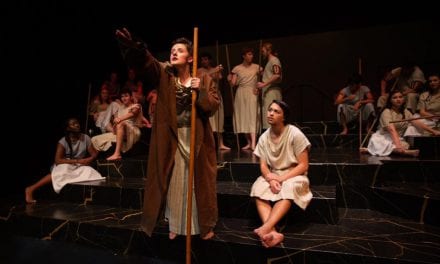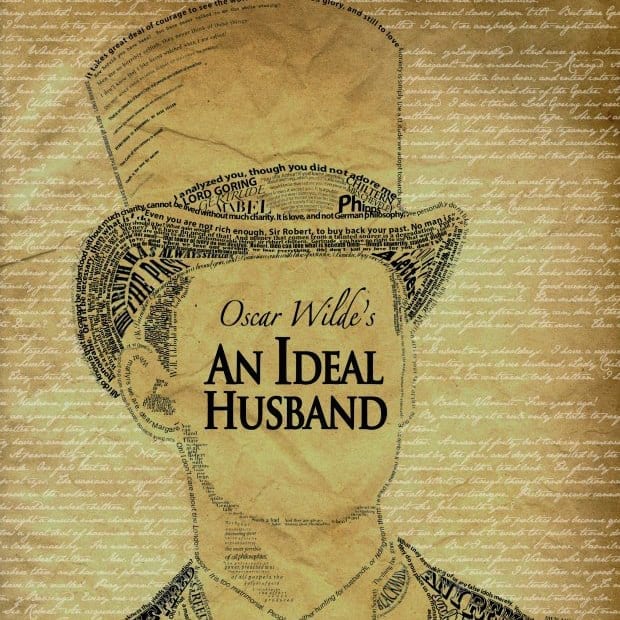SALT LAKE CITY — Stop Kiss currently playing at Studio 115 at the University of Utah is a play with a series of scenes leading up to and following a kiss. Told in flashback/flash-forward style, the audience sees the relationship develop alongside the aftermath of a first kiss. When Callie (Marin Kohler) and Sara (Emilia Stawicki) meet, they become easy friends. Both have a history of dating men, but soon their attraction for each other leads them down a path that both are apprehensive about. When their first kiss finally occurs on a park bench, a man turns the magic of that first kiss into a tragic and violent attack.
Callie is a New York City traffic reporter. She gets to ride around in a helicopter and tell all the people who own cars that traffic is a mess every ten minutes, yet she doesn’t even have a car. Sara is a newly arrived 3rd grade school teacher from St. Louis. She teaches in the Bronx on a fellowship created in the name of a teacher from the same area who was killed by one of his students.
Begrudgingly, Callie agrees to take care of Sara’s cat as a favor to a friend. When the two meet, their friendship begins like most friendships with some awkwardness and the typical getting-to-know-you questions. The two contrast each other nicely with Callie living a bit of whirlwind of life. From her sometimes-casual boyfriend (Mike T. Brown) who she’ll “probably marry” to the chaotic mess that is her apartment, Callie lives life for today. Sara, on the other hand, left her family and steady boyfriend (Jeffrey Black) of several years to teach kids in an area that by most would be considered incredibly dangerous. Sara is more reserved, driven, and steady.
From frantically running around the apartment in apprehension for Sara’s first visit, to her easy interactions and banter with her sometimes boyfriend George, Kohler delivers a strong performance. The juxtaposition of her scenes before and post attack called for transitions between shock, friendship, anger, laughter, concern and sadness in mere seconds at times. I had a hard time moving from the scene where she describes the attack with real tears to moments later, laughing and hanging out with Sara. I can only imagine the difficulty in actually performing these scenes back to back.
Stawicki’s role called for more steadiness and reservation. Her quiet grace and movement, especially in her physicality seemed a solid grounding for Kohler. She was able to convey the journey of the timid schoolteacher at the beginning to a woman who would be willing to stand up for herself in a bad situation. Stawicki really brought a subtle softness and strength that again contrasted beautifully with Callie’s disorganized life.
In an exploration of love, gender roles and the reactions of people to a homosexual relationship, playwright Diana Son builds an entirely believable world, void of stereotypical “gay themes.” Rather, she focuses on two women, who for all intents and purposes are considered “straight.” Stop Kiss is not even about the journey of “coming out” or “inequality.” It transcends “gay rights” and becomes the journey of two women who have an incredibly strong friendship and recognize the opportunity to discover love and joy within that relationship.
However, Stop Kiss also takes into consideration how their relationship impacts those in their lives. Dramaturg Curtis Russell quoted Suzanne Pharr in the playbill, “A woman without a man is told she is vulnerable to external violence and worse, that there is something wrong with her . . . she is choosing to be outside society’s protections from male institutions and therefore from wide-ranging, unspecified, ever present violence.” Interestingly, the women never identify as gay or lesbian. In fact, after going to a lesbian bar one remarks “It’s just a bar with a whole bunch of lesbians in it . . . and us.” So, when Callie suddenly becomes the “Lesbian traffic girl report whose lover was beaten up” she struggles and asks an unconscious Sara, “Do you know who I am?”
The smattering of supporting characters were all cast wonderfully. Jordan T. Borup as Detective Cole was a jerk. Borup’s tone, physical presence and general tension in his portrayal nearly had me booing him at curtain call. Well done! Anna Schovaers contrasted her two roles so well that I doubted for a moment that it was the same woman. The gentleness of the nurse and the no non-sense of Mrs. Winsley were both adeptly conveyed. Black’s scene in which he asks Callie if the attacker was bigger than him was engaging because behind the anger you could sense his pain and helplessness. This scene was one of my favorite moments of the night. And last but not least, the comedic relief and personality that Brown brought to sometimes-boyfriend George had me thrilled every time he was on stage. From his lackadaisical attitude contrasting with his anger after the attack, he showed real depth. In short, I’d like him on my team of friends in a bad situation. His loyalty to Callie was moving.
Director Karen Salazar created a believable world. The lighting (Chris Marcellus) and settings of the scene where Callie details the attack were beautifully staged with the focus being drawn into the intensity of the emotion. The transitions between pre- and post-kiss hospital scenes were disquieting and served to set the audience to unease. However, I would have liked to see more time spent at the end of Act I. This moment had such possibility for emotion and impact had it been it a little less rushed. However, the ending was wonderfully paced and ended on the perfect note.
Overall, the production was well done and a moving one. I am certainly glad I had the opportunity to see it. Obviously, it has some language, deals with same-gender relationships, and violence so a parenteral advisory is recommended.






